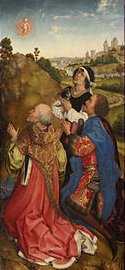Rod Dreher. How Dante Can Save Your Life. New York: Regan Arts, 2015. E-book.
Then she opened up a book of poems
And handed it to me
Written by an Italian poet
From the thirteenth century
And every one of them words rang true
And glowed like burning coal
Pourin’ off every page
Like it was written in my soul…
Bob Dylan, “Tangled Up in Blue”
This book begins with a comment that should get the reader’s attention: “I don’t much like poetry. Never have.” But the author then proceeds to tell how reading through Dante’s Divine Comedy helped him cope with difficulties in life.
Believe it or not, this book in some ways was not unlike Lost Among the Birds. That book told of the author’s struggle with depression and how recovery from that paralleled his pursuit of a big year. So How Dante Can Save Your Life is really an autobiography in which Dante’s epic plays a significant part.
I was familiar with Dreher, having read some articles he had written, and I knew he had written The Benedict Option, which is written for a Christian audience. I have enjoyed The Divine Comedy, though I have never read it analytically or studied it academically. Dreher’s book was (and still is as of this posting) a bargain on Amazon. Why not?
Unlike the author of the Lost Among the Birds, Dreher was not struggling with depression specifically. His problem was more elemental: family conflict. Dreher grew up in rural Louisiana and pursued a fairly successful career as a journalist, actually ending up at the New York Post.
But his family never accepted his career choice. Both his father and his only sister felt that he had abandoned the family and everything that they stood for. Both of them were highly esteemed in the home parish (Louisiana has parishes instead of counties), so there was a tendency to see him as a rebel or a black sheep. From his perspective, he really was not those things, he just had other interests. He writes: “There has never been a time in my life when I have not acutely felt that I was disappointing my father.” (7)
(I could identify with this to a degree; I always felt my father was disappointed that I majored in English rather than pursuing a career in finance.)
Dreher with his wife and kids moved back to his hometown. He made friends and established himself there but never was able to connect to most of his close relatives other than one niece. There were other issues, but this long-simmering conflict would continue to beset him, and he was at a loss what to do.
Sadly, his sister died in her early forties. Dreher wrote a book in her honor, The Little Way of Ruthie Leming. It really is a hagiography, and he received many compliments and a few honors for it. In spite of the very positive presentation of Ruthie in the book, most of his family considered it self-serving and were still convinced that he did not like them or even his sister whom he praises so much in the book.
He did become involved in some counseling both from a licensed counselor and his priest (he tells how he joined the Orthodox Church). At the same time he picked up a copy of Dante. Much of this tells how it spoke to him. It also is not a bad introduction to the Divine Comedy itself.
Dreher tells how as a reporter he had reported on the priest sexual abuse and cover-up scandal in the Catholic Church. He continued to remain Catholic because of his beliefs. He and his wife found a parish that they really liked and appreciated the priests, until it was revealed that even one of those priests had been involved in the abuse and the diocese had covered it up. Shortly after that, they joined an Orthodox congregation.
Dreher notes that Dante really spoke to him because in Dante’s day the Roman Church was corrupt. Dante places one of the recent popes and a number of other clerics in hell. But Dante remained faithful to the church because it still represented what is true and holy even if some of its practitioners did not.
Perhaps the most helpful thing for the reader is that he explains how the Divine Comedy really represents the Christian life on earth as much as it does the afterlife. The Inferno shows us the consequences of sin, and not simply the final punishment of sin. Each of the punishments reflects the hearts of the people who would commit that sin. For Dreher, as for others, this becomes a kind of mirror. He does not describe every circle, but only those that convicted him in his life, but he does an admirable job.
Throughout the book as Dreher looks at his own life and Dante’s epic, he focuses on love. So he notes, as does Dante, “sin is not at heart, a violation of a legalistic code, but rather a distortion of love. In Dante, sinners—and we are all sinners—are those who love the wrong things, or who love the right things in the wrong way.” (76)
How then, can he love his family? In a right way? Can they love him? In a right way?
Dreher admits that he does not believe in Purgatory. It is a dogma only of the Catholic Church. Neither Protestant nor Orthodox teach it. Dante’s Purgatorio describes people who believe in God but who are not yet pure enough to enter heaven. Each person there has to climb a mountain to gradually slough off their sin nature so they can enter heaven.
Dreher says that this is like the Christian walk in this earth. As we go through life, if the Lord is working in our lives, He gradually works on our emotions, mind, and will to make us more the kinds of people He wants us to be. So Dreher compares his own struggles to the struggles of some of those mountain climbers in Purgatory.
Dreher spends little time reacting to or describing the Paradiso. Perhaps that is because he does not believe he has arrived yet. Still, he understands it as an ideal and perfect place with Christ Himself at the center.
Hell is a dark and loveless place of absolute egotism. Heaven is filled with love, light, and the complete absence of ego. Purgatory is life as we experience it: a never-ending contest between love and hate, altruism and selfishness, good and evil—and the way we respond to these challenges matters. (44)
The author did not become a Catholic until he was nearly thirty. He understands current mores in the wider society. He sometimes interprets for a modern audience:
To be a heretic in Dante’s era was to disbelieve Catholic orthodoxy. Today, a broader, more secular definition is to believe that partial truths are whole truths. It takes steady, unflinching examination of our own consciences to uncover idol-making heresies—that is, beliefs that hold relative goods to be absolute.(127)
So Dreher examines his own life and looks for the half-truths. Was he expecting too much of his father and sister? Why did he need the approval of others? How do these things affect his relationship with his own wife and children? With God?
There is much more. This book takes a look at contemporary culture. Dante’s story begins “in a dark wood.” That is how Dreher felt. Alas, so many people today end up that way because they feel they have to achieve. Dreher had done very well in his chosen field, but still felt rejected by his family.
Dante’s own life was one of achievement until he found himself on the wrong side of a political controversy and was exiled from his thriving Florence home for the rest of his life. Only then could he write The Divine Comedy. So we learn about the poet as well his poem.
In the Inferno Dante and Dreher learn the truth about themselves. In Purgatorio they live out the truth in their daily lives. (186) One thing that Dreher said that both he and Dante had to learn to give up “on the possibility of getting justice in this life.” (229)
In Paradiso we see God’s design and plan for His people.
God does not expect you to be the same as everyone else. He only wants you to be perfected in the nature that he gave you and find your place in the harmony of the cosmos. (281)
We also have to understand that God’s salvation is not earned. To Dreher, Dante, and the Bible, it is to an act of mercy. (275) Blessed be the name of the Lord. In heaven:
Everything within Dante has been mystically and flawlessly joined to the will of God. He has reached the end of all his strivings. He has been perfected in Love. [author’s capital letter] No longer subject to the highs and the lows of Fortune’s wheel, the pilgrim now abides at the hub, the fixed point around which the universe turns. (279)
Dreher’s discovery of Dante results in recovery. He says he came back to Louisiana to find Utopia but instead found God. Eternity matters. Dreher notes near the end:
Boris Pasternak wrote that his suffering under communism made him see the Bible “not so much as a book with hard and fast text as the notebook of humanity and a key to everything eternal.” (292)
Life is short. Eternity is everlasting.
How Dante Can Save Your Life is actually an excellent book for counselors. Dreher shares a lot about what both his Baptist counselor and his Orthodox priest shared in counseling and confessional sessions. It is a moving tale that reminds us of the power of the word and the challenges of forgiveness.
The author has a bibliography for anyone who wants to get into Dante more. He also quotes from a few different translations to give us English speakers a taste of which one we might prefer. It might get a reader looking into it once again.

